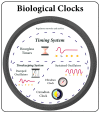Studying the Human Microbiota: Advances in Understanding the Fundamentals, Origin, and Evolution of Biological Timekeeping
- PMID: 38003359
- PMCID: PMC10671191
- DOI: 10.3390/ijms242216169
Studying the Human Microbiota: Advances in Understanding the Fundamentals, Origin, and Evolution of Biological Timekeeping
Abstract
The recently observed circadian oscillations of the intestinal microbiota underscore the profound nature of the human-microbiome relationship and its importance for health. Together with the discovery of circadian clocks in non-photosynthetic gut bacteria and circadian rhythms in anucleated cells, these findings have indicated the possibility that virtually all microorganisms may possess functional biological clocks. However, they have also raised many essential questions concerning the fundamentals of biological timekeeping, its evolution, and its origin. This narrative review provides a comprehensive overview of the recent literature in molecular chronobiology, aiming to bring together the latest evidence on the structure and mechanisms driving microbial biological clocks while pointing to potential applications of this knowledge in medicine. Moreover, it discusses the latest hypotheses regarding the evolution of timing mechanisms and describes the functions of peroxiredoxins in cells and their contribution to the cellular clockwork. The diversity of biological clocks among various human-associated microorganisms and the role of transcriptional and post-translational timekeeping mechanisms are also addressed. Finally, recent evidence on metabolic oscillators and host-microbiome communication is presented.
Keywords: TTFL; biological clock; cellular timekeeping; circadian rhythm; evolution; metabolic oscillations; microbiome; peroxiredoxins.
Conflict of interest statement
The authors declare no conflict of interest.
Figures






Similar articles
-
Interplay between cellular redox oscillations and circadian clocks.Diabetes Obes Metab. 2015 Sep;17 Suppl 1:55-64. doi: 10.1111/dom.12519. Diabetes Obes Metab. 2015. PMID: 26332969 Review.
-
Rethinking the clockwork: redox cycles and non-transcriptional control of circadian rhythms.Biochem Soc Trans. 2014 Feb;42(1):1-10. doi: 10.1042/BST20130169. Biochem Soc Trans. 2014. PMID: 24450621
-
Circadian redox oscillations and metabolism.Trends Endocrinol Metab. 2015 Aug;26(8):430-7. doi: 10.1016/j.tem.2015.05.012. Epub 2015 Jun 22. Trends Endocrinol Metab. 2015. PMID: 26113283 Free PMC article. Review.
-
Circadian redox and metabolic oscillations in mammalian systems.Antioxid Redox Signal. 2014 Jun 20;20(18):2966-81. doi: 10.1089/ars.2013.5582. Epub 2013 Nov 22. Antioxid Redox Signal. 2014. PMID: 24063592 Free PMC article. Review.
-
Metabolic and nontranscriptional circadian clocks: eukaryotes.Annu Rev Biochem. 2014;83:165-89. doi: 10.1146/annurev-biochem-060713-035623. Epub 2014 Mar 3. Annu Rev Biochem. 2014. PMID: 24606143 Free PMC article. Review.
Cited by
-
The Role of Gut Microbiome in Sleep Quality and Health: Dietary Strategies for Microbiota Support.Nutrients. 2024 Jul 13;16(14):2259. doi: 10.3390/nu16142259. Nutrients. 2024. PMID: 39064702 Free PMC article. Review.
-
Mechanism of Action of Melatonin as a Potential Adjuvant Therapy in Inflammatory Bowel Disease and Colorectal Cancer.Nutrients. 2024 Apr 21;16(8):1236. doi: 10.3390/nu16081236. Nutrients. 2024. PMID: 38674926 Free PMC article. Review.
-
Chronodisruption and Gut Microbiota: Triggering Glycemic Imbalance in People with Type 2 Diabetes.Nutrients. 2024 Feb 23;16(5):616. doi: 10.3390/nu16050616. Nutrients. 2024. PMID: 38474745 Free PMC article. Review.
References
Publication types
MeSH terms
LinkOut - more resources
Full Text Sources

